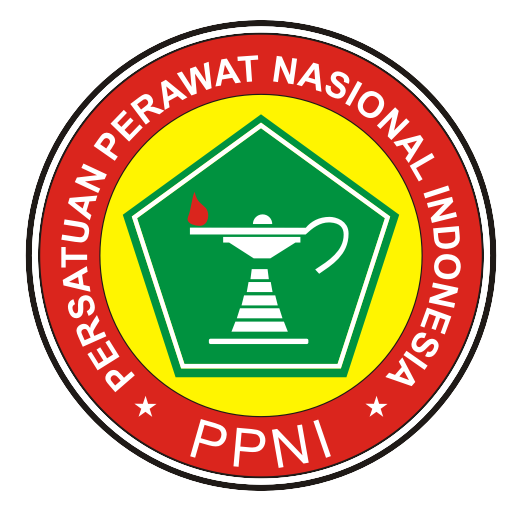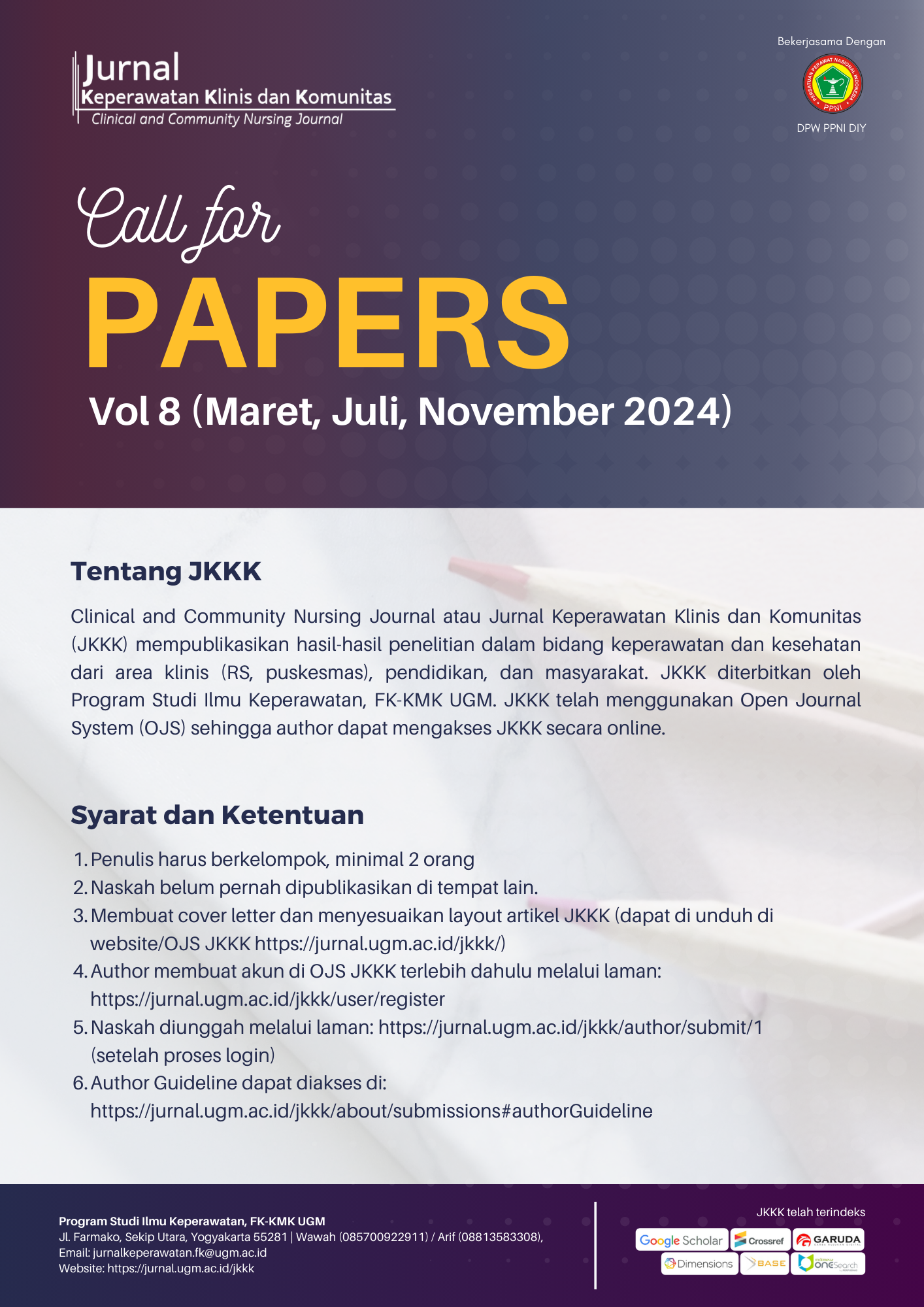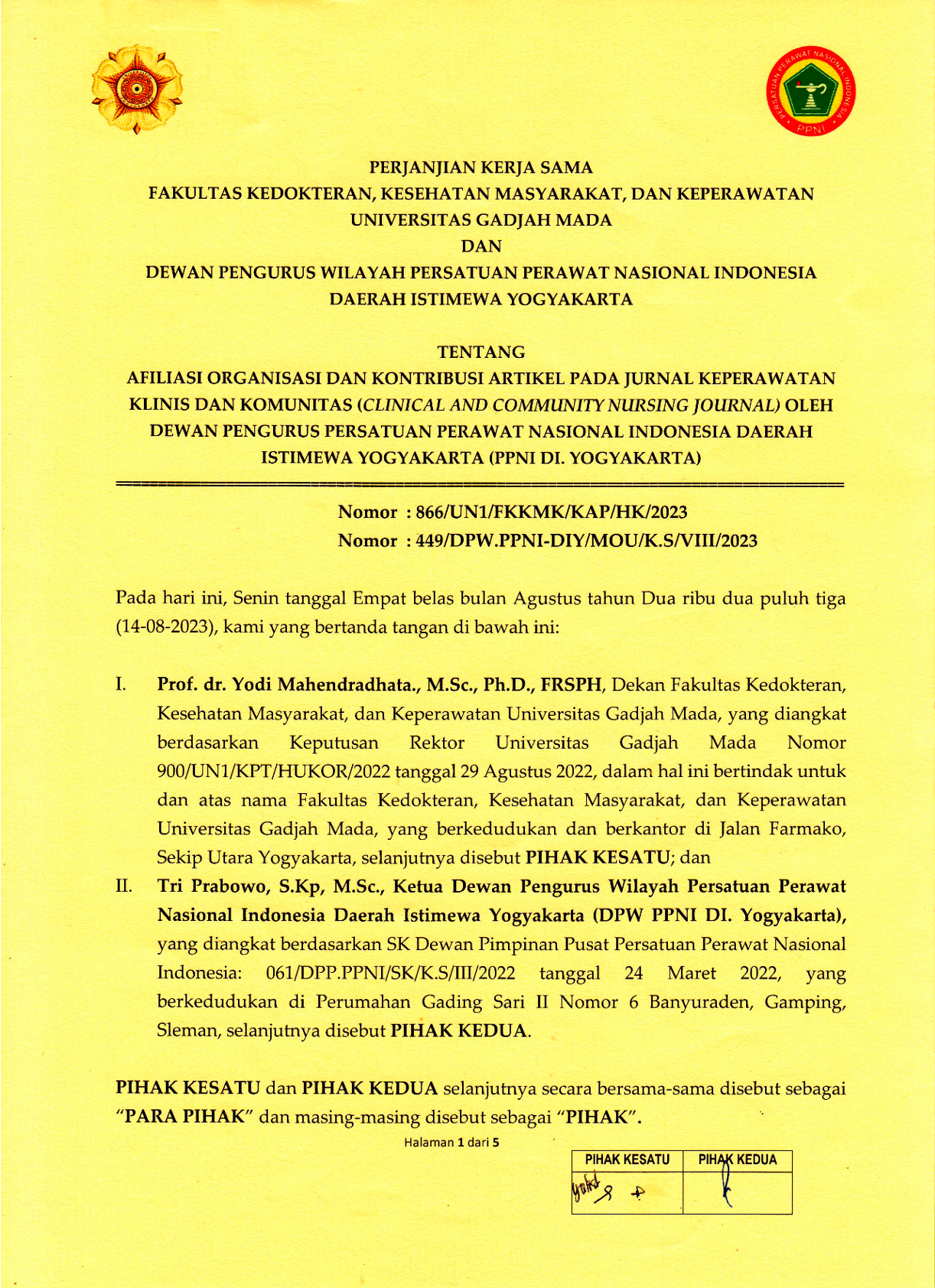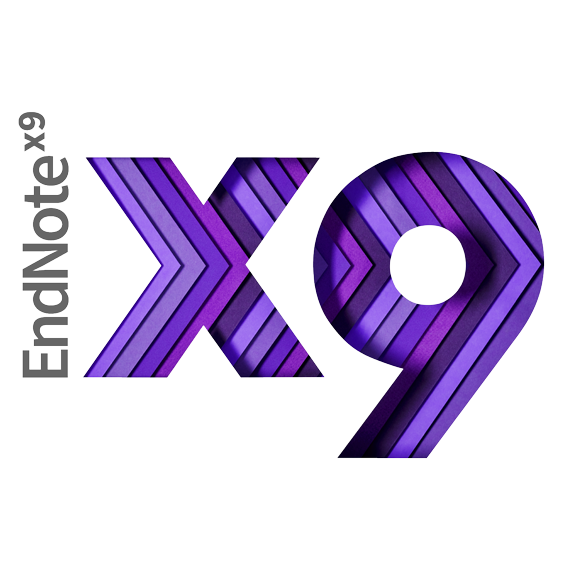Pengaruh Self-Selected Individual Music Therapy (SeLIMuT) terhadap Cancer Related Fatigue (CRF) pada Pasien Kanker
Gracia Rosiharjati Sarihastanti(1*), Sri Setiyarini(2), Christantie Effendy(3)
(1) Program Studi Ilmu Keperawatan, Fakultas Kedokteran, Kesehatan Masyarakat, dan Keperawatan, Universitas Gadjah Mada
(2) Departemen Keperawatan Dasar dan Emergensi, Fakultas Kedokteran, Kesehatan Masyarakat, dan Keperawatan, Universitas Gadjah Mada
(3) Departemen Keperawatan Medikal Bedah, Fakultas Kedokteran, Kesehatan Masyarakat, dan Keperawatan, Universitas Gadjah Mada
(*) Corresponding Author
Abstract
Background: Cancer is the second leading cause of death globally. Patients with cancer have various problems, both physicaly and physiologicaly, that are caused by the cancer itself or the effect of its treatment. One of the most common problems is cancer related fatigue (CRF). Music therapy is a kind of intervention to decrease CRF in cancer patient.
Objective: To understand the effect of Self-Selected Individual Music Therapy (SeLIMuT) intervention toward CRF and to measure relative risk between SeLIMuT and CRF.
Method: The design of this study was cohort retrospective with analytic observational approach. Research was conducted in IRNA 1 RSUP Prof. Sardjito Yogyakarta, Teratai and Bougenville unit of RSUD Prof. Margono Soekarjo Purwokerto. Respondents were divided into non exposure group with standard care in hospital (n = 21) and exposure group (n = 21) with SeLIMuT therapy four times in two days within 15-20 minutes. CRF was assessed in both group using visual analogue scale (VAS) Fatigue and had been put in observational sheet. This study used independent T test to measure the effect of SeLIMuT on CRF. The relative risk was calculated using RR with 95% confidence interval (CI).
Results: The result of the study showed that there was difference in average pre post in both groups with score 8,33 in SeLIMuT group and -1,53 in non SeLIMuT group with score of p = 0,00 (p < 0,05). CRF occurred in SeLIMuT group was decreased after intervention. The relative risk was measured using RR and the result was 5,00.
Conclusion: SeLIMuT intervention is an effective intervention to reduce CRF.
Latar belakang: Kanker merupakan penyebab kematian kedua di dunia. Pasien kanker mengalami banyak permasalahan fisik dan psikis, baik karena efek proses penyakit maupun dari efek samping pengobatan. Masalah yang banyak timbul pada pasien kanker adalah cancer related fatigue (CRF). Salah satu intervensi yang digunakan untuk mengatasi CRF adalah terapi musik.
Tujuan: Mengetahui pengaruh Self-Selected Individual Music Therapy (SeLIMuT) terhadap CRF.
Metode: Penelitian diambil dari data sekunder penelitian SeLIMUT menggunakan metode observasional analitik dengan pendekatan cohort retrospective yang dilakukan di IRNA 1 RSUP Prof. Sardjito Yogyakarta serta bangsal Teratai dan Bougenville RSUD Prof. Margono Soekarjo Purwokerto. Responden dibagi dalam kelompok intervensi (n = 21) yang menerima SeLIMuT sebanyak empat kali dalam dua hari masing-masing selama 15-20 menit dan kelompok kontrol (n = 21) yang hanya mendapatkan perawatan standar rumah sakit. Visual analogue scale (VAS) fatigue digunakan untuk menilai outcome CRF yang dilakukan sebelum (pretest) dan setelah (posttest). Uji pengaruh SeLIMuT terhadap CRF menggunakan independent T test. Uji besar risiko menggunakan relative risk (RR) dengan confidence interval (CI) sebesar 95%.
Hasil: terdapat perbedaan rerata selisih pre-post pada kelompok intervensi sebesar 8,33 dan kelompok kontrol -1,53 dengan nilai p = 0,001 (p < 0,005). Hal ini menunjukkan bahwa terapi SeLIMuT berpengaruh terhadap penurunan CRF pada pasien kanker. RR didapatkan sebesar 5,00. Hal ini berarti bahwa SeLIMuT memiliki efek yang cukup besar terhadap penurunan CRF. Pasien kanker dengan SeLIMuT berpeluang tidak mengalami CRF kategori tidak lelah-lelah ringan 5x lebih banyak dibanding kelompok yang tidak mendapat intervensi.
Kesimpulan: SeLIMuT dapat berpengaruh positif terhadap penurunan cancer related fatigue pada pasien kanker.
Keywords
Full Text:
PDFReferences
- WHO. WHO_Cancer [Internet]. 2017 [cited 2017 Apr 5]. Available from: http://www.who.int/mediacentre/factsheets/fs297/en.
- Kemenkes. Kementerian Kesehatan Republik Indonesia 2016 Kanker [Internet]. 2016. Available from: http://www.depkes.go.id/article/view/16080300004/rsup-dr-sardjito-resmikan-instalasi-kanker-untuk-penuhi-kebutuhan-pelayanan-kesehatan-masyarakat.html.
- Kemenkes. Situasi Penyakit Kanker. 2017; Available from: http://www.depkes.go.id/resources/download/pusdatin/infodatin/infodatin-kanker.pdf.
- Johnson JY. Handbook for Brunner & Suddarth’s Textbook of Medical Surgical Nursing. 2010. 591-594 p.
- National Cancer Institute. Understanding Cancer Prognosis - National Cancer Institute. 2014.
- American Cancer Society. Acute Lymphocytic Leukemia (ALL) in Adults [Internet]. 2017 [cited 2017 May 3]. Available from: https://www.cancer.org/cancer/acute-lymphocytic-leukemia.html.
- Hofman M, Ryan JL, Figueroa-Moseley CD, Jean-Pierre P, Morrow GR. Cancer-Related Fatigue: The Scale of The Problem. Oncologist. 2007; 12(1): 4–10.
- Bower JE, Ganz PA, Desmond KA, Rowland JH, Meyerowitz BE, Belin TR. et al: Fatigue in Breast Cancer Survivors: Occurrence, Correlates, and Impact on Quality of Life. J Clin Oncol. 2000; 18(4): 743–53.
- Echteld MA, Passchier J, Teunissen S, Claessen S, de Wit R, van der Rijt CCD. Multidimensional Fatigue and Its Correlates in Hospitalised Advanced Cancer Patients. Eur J Cancer. 2007; 43(6): 1030–6.
- NCCN. Cancer-Related Fatigue. Clin Pract Guidel Oncol Cancer Related-Fatigue [Internet]. 2016; 5. Available from: https://www.nccn.org/professionals/physician_gls/pdf/fatigue.pdf.
- Yeo TP, Cannaday S. Cancer-Related Fatigue: Impact on Patient Quality of Life and Management Approaches. Nursing: Research and Reviews. 2015. p. 65.
- Curt GA, Breitbart W, Cella D, Groopman JE, Horning SJ, Itri LM, et al. Impact of Cancer-Related Fatigue on The Lives of Patients: New Findings from The Fatigue Coalition. Oncologist [Internet]. 2000; 5(5): 353–60. Available from: http://www.ncbi.nlm.nih.gov/pubmed/11040270%5Cnhttp://theoncologist.alphamedpress.org/ content/5/5/353.full.pdf.
- Diaz N, Menjon S, Rolfo C, Garcia-Alonso P, Carulla J, Magro A, et al. Patients’ Perception of Cancer-Related Fatigue: Results of A Survey to Assess The Impact on Their Everyday Life. Clin Transl Oncol. 2008; 10(11): 753–7.
- National Cancer Institute. Fatigue (PDQ®)—Patient Version - National Cancer Institute [Internet]. 2015. Available from: https://www.ncbi.nlm.nih.gov/pmc/articles/PMC3281752/pdf/nihms355468.pdf.
- Berndt E, Kallich J, Anne M, Xu X, Lee H, Glaspy J. Reductions in Anaemia and Fatigue are Associated with Improvements in Productivity in Cancer Patients Receiving Chemotherapy. 2005; 23(5): 505–14. Available from: https://link.springer.com/article/10.2165/00019053-200523050-00009.
- American Cancer Society. What Is Cancer-Related Fatigue [Internet]. 2016 [cited 2017 Apr 24]. Available from: https://www.cancer.org/treatment/treatments-and-side-effects/physical-side-effects/fatigue/what-is-cancer-related-fatigue.html.
- Munch TN, Strömgren AS, Pedersen L, Petersen MA, Hoermann L, Groenvold M. Multidimensional Measurement of Fatigue in Advanced Cancer Patients in Palliative Care: An Application of The Multidimensional Fatigue Inventory. J Pain Symptom Manage. 2006; 31(6): 533–41.
- American Cancer Society. Managing Cancer-Related Fatigue [Internet]. 2016 [cited 2017 Apr 24]. Available from: https://www.cancer.org/treatment/treatments-and-side-effects/physical-side-effects/fatigue/managing-cancer-related-fatigue.html.
- Carroll JK, Kohli S, Mustian KM, Roscoe JA, Morrow R. Pharmacologic Treatment of Cancer-Related Fatigue. 2007;12(suppl 1):43–51. Available from: http://theoncologist.alphamedpress.org/content/12/suppl_1/43.full.pdf+html.
- Minton O, Richardson A, Sharpe M, Hotopf M, Stone P. Drug Therapy for The Management of Cancer-Related Fatigue (Review) Summary of Findings for The Main Comparison. 2010; (7).
- Marchand L. Integrative and Complementary Therapies for Patients with Advanced Cancer. 2014; 3(3): 160–71.
- Kaliyaperumal R, Gowri J. Effect of Mfusic Therapy for Patients with Cancer Pain. Int J Biol Med Res. 2010; 3(3): 79–81.
- Hawks J, Moyad M. CAM: Definition and Classification Overview. Urol Nurs. 2003; 23(3): 221–3.
- Clair AA, Memmott J. Therapeutic Uses of Music with Older Adults. Second Edition [Internet]. American Music Therapy Association; 2008. Available from: https://eric.ed.gov/?id=ED504544.
- Werner A. Healing Vibrations: The Effects of Music Therapy in Cancer Patients [Internet].
- Cancer Education Foundation. 2016. Available from: http://amacf.org/healing-vibrations-the-effects-of-music-therapy-in-cancer-patients.
- Stanczyk MM. Music Therapy in Supportive Cancer Care. Reports Pract Oncol Radiother [Internet]. 2011; 16(5): 170–2. Available from: http://dx.doi.org/10.1016/j.rpor.2011.04.005.
- Cancer Research UK. Music Therapy _ Cancer in General _ Cancer Research UK [Internet]. 2015 [cited 2017 Aug 24]. Available from: http://www.cancerresearchuk.org/about-cancer/cancer-in-general/treatment/complementary-alternative-therapies/individual-therapies/music.
- Mucci K, Mucci R. The Healing Sound of Music: Manfaat Musik untuk Kesembuhan, Kesehatanmu, dan Kebahagiaan Anda. Jakarta: Gramedia Pustaka Utama; 2002.
- Yun YH, Lee MK, Park SM, Kim YA, Lee WJ, Lee KS, et al. Effect of Complementary and alternative medicine on The Survival and Health-Related Quality of Life among Terminally Ill Cancer Patients: A Prospective Cohort Study. 2013; (October 2012): 489–94.
- Koornstra RHT, Peters M, Donofrio S, Borne B Van Den, Jong FA De. Management of Fatigue in Patients with Cancer – A Practical Overview. CANCER Treat Rev [Internet]. 2014;49. Available from: http://dx.doi.org/10.1016/j.ctrv.2014.01.004.
- Bower JE, Crosswell AD, Slavich GM. Childhood Adversity and Cumulative Life Stress: Risk Factors for Cancer-Related Fatigue. Clin Psychol Sci $b a J Assoc Psychol Sci. 2014; 2(1): 10.1177/2167702613496243.
- Lopes-Junior LC, Bomfim EO, Nascimento LC, Nunes MDR, Pereira-da-Silva G, Lima RAG. Non-Pharmacological Interventions to Manage Fatigue and Psychological Stress in Children and Adolescents with Cancer: An Integrative Review. Eur J Cancer Care (Engl). 2016; 25(6): 921–35.
- Hertanti N, Setiyarini S, Kristanti MS. Pengaruh Self-Selected Individual Music Therapy (SeLIMuT) terhadap Tingkat Nyeri Pasien Kanker Paliatif di RSUP Dr. Sardjito Yogyakarta. 2013.
- Tursina HM, Setiyarini S, Kristanti MS, Haryani. Pengaruh Self-Selected Individual Music Therapy (SeLIMuT) terhadap Tingkat Kecemasan Pasien Kanker Paliatif di RSUP Dr. Sardjito Yogyakarta. 2013.
- Kurniawan D, Setiyarini S, Kristanti MS. Pengaruh Self-Selected Individual Music Therapy (Selimut) terhadap Perubahan Status Hemodinamik Pasien Kanker Paliatif di Rsup Dr. Sardjito Yogyakarta [Internet]. 2013. Available from: http://etd.repository.ugm.ac.id/index.php?mod=penelitian_detail&sub=PenelitianDetail&act=v iew&typ=html&buku_id=62716.
- Armes J, Chalder T, Addington-Hall J, Richardson A, Hotopf M. A randomized controlled trial to evaluate the effectiveness of a brief, behaviorally oriented intervention for cancer-related fatigue. Cancer. 2007; 110(6): 1385–95.
- Vickers AJ, Ph D, Magill LA, Edmundson A, Kelly B, Spencer L. Music Therapy for Mood Disturbance during Hospitalization for Autologous Stem Cell. Am Cancer Soc. 2003.
- Fredenburg HA, Silverman MJ. Effects of Cognitive-Behavioral Music Therapy on Fatigue in Patients in A Blood and Marrow Transplantation Unit: A Mixed-Method Pilot Study. Arts Psychother [Internet]. 2014; 41(5): 433–44. Available from: http://dx.doi.org/10.1016/j.aip.2014.09.002.
- Choi YK. The Effect of Music and Progressive Muscle Relaxation on Anxiety, Fatigue, and Quality of Life in Family caregivers of Hospice Patients. J Music Ther [Internet]. 2010; 47(1): 53– 69. Available from: http://onlinelibrary.wiley.com/o/cochrane/clcentral/articles/160/CN-00749160/frame.html.
- Fossa SD, Dahl AA, Loge JH. Fatigue, Anxiety, and Depression in Long-term Survivors of Testicular Cancer. J Clin Oncol. 2003; 21(7): 1249–54.
- Oh HS, Seo WS. Systematic Review and Meta-Analysis of The Correlates of Cancer-Related Fatigue. Worldviews Evidence-Based Nurs. 2011; 8(4): 191–201.
- Clark M, Isaacks-Downtown G, Wells N, Sheryl Redlin-Frazier, Eck C, T.Hepworth J, et al. Use of Preferred Music to Reduce Emotional Distress and Symptom Activity during Radiation Therapy. J Music Ther [Internet]. 2006;43(3):247–65. Available from: https://www.ncbi.nlm.nih.gov/pubmed/17037953.
- Djohan. Terapi Musik, Teori, dan Aplikasi. Yogyakarta: Galangpress; 2006.
- Harding R, Selman L, Agupio G, Dinat N, Downing J, Gwyther L, et al. The Prevalence and Burden of Symptoms amongst Cancer Patients Attending Palliative Care in Two African Countries. Eur J Cancer [Internet]. 2011; 47(1): 51–6. Available from: http://dx.doi.org/10.1016/j.ejca.2010.08.003.
- Effendy C, Vissers K, Osse BHP, Tejawinata S, Vernooij-Dassen M, Engels Y. Comparison of Problems and Unmet Needs of Patients with Advanced Cancer in a European Country and An Asian Country. Pain Pract [Internet]. 2015;15(5):433–40. Available from: http://onlinelibrary.wiley.com/doi/10.1111/papr.12196/abstract;jsessionid=A71E7171CFCFE7 E3B921761BB8A53219.f04t03
- Elwafi PR, Wheeler BL. Listening to Music as Part of Treatment for Breast Cancer: A Qualitative Content Analysis of Patients’ Listening Logs. Arts Psychother [Internet]. 2016; 48(2016): 38–45. Available from: http://dx.doi.org/10.1016/j.aip.2015.12.004.
- Ryan JL, Carroll JK, Ryan EP, Mustian KM, Fiscella K, Morrow GR. Mechanisms of Cancer-Related Fatigue. Oncologist [Internet]. 2007; 12(suppl_1): 22–34. Available from: http://theoncologist.alphamedpress.org/cgi/doi/10.1634/theoncologist.12-S1-22.
- Wang XS. NIH Public Access. Pathophysiol Cancer-Related Fatigue [Internet]. 2012; 12(Figure 1): 11–20. Available from: https://www.ncbi.nlm.nih.gov/pmc/articles/PMC3281752/pdf/nihms355468.pdf.
- Allen J. Adults with cancer. In J. Allen (Ed.), Guidelines for Music Therapy Practice in Adult Medical Care. IL: Barcelona: University Park; 2013. 265-294 p.
- Wakim JH, Smith S, Guinn C. The Efficacy of Music Therapy. J Perianesthesia Nurs [Internet]. 2010; 25(4): 226–32. Available from: http://dx.doi.org/10.1016/j.jopan.2010.05.009.
- Barrett K, Brooks H, Boitano S, Barman S. Ganong’s Review of Medical Physiology. Ganong’s Review of Medical physiology. 2010. 111-112, 144, 293-294 p.
- Burns DS. The Effect of The Bonny Method of Guided Imagery and Music on The Mood and Life Quality of Cancer Patients. 2001; (July 1999): 51–65.
- Ferrer AJ. The Effect of Live Music on Decreasing Anxiety in Patients Undergoing Chemotherapy Treatment. 2007; (3): 242–55.
- Davis WB, Gfeller KE, Thaut M. An Introduction to Music Therapy: Theory and Practice Second edition. Boston: McGraw-Hill; 1999.
- Tursina HM, Setiyarini S, Kristanti MS. Self – Selected Individual Music Therapy. 2012.
- Bernatzky G, Strickner S, Presch M, Wendtner F, Kullich W. Music as Non-Pharmacological Pain Management in Clinics. Music Heal Wellbeing. 2012; 257–75.
- Mitchell L, MacDonald RR. An Experimental Investigation of The Preferred and Relaxing Music Listening on Pain Perception. J Music Ther. 2006; 43(4): 295–316.
- Mitchell LA, MacDonald RAR, Brodie EE. A Comparison of The Effects of Preferred Music, Arithmetic and Humour on Cold Pressor Pain. Eur J Pain. 2006; 10(4): 343–51.
- Dillon T, Serpell MG. Empirical Investigation of The Anxiolytic and Pain Reducing Effects of Music. Pdf : 187–203.
- Jankord R, Herman JP. Limbic Regulation of Hypothalamo-Pituitary-Adrenocortical Function during Acute and Chronic Stress. Ann N Y Acad Sci. 2008; 1148: 64–73.
- Hellhammer DH, Wüst S, Kudielka BM. Salivary Cortisol as A Biomarker in Stress Research. Psychoneuroendocrinology. 2009; 34(2): 163–71.
- Chanda ML, Levitin DJ. The Neurochemistry of Music. Trends Cogn Sci [Internet]. 2013; 17(4): 179–91. Available from: http://dx.doi.org/10.1016/j.tics.2013.02.007.
- Hayama Y, Inoue T. The Effects of Deep Breathing on “Tension-Anxiety” and Fatigue in Cancer Patients Undergoing Adjuvant Chemotherapy. Complement Ther Clin Pract [Internet]. 2012; 18(2): 94–8. Available from: http://dx.doi.org/10.1016/j.ctcp.2011.10.001.
- Pryor JA PS. Physiotherapy for Respiratory and Cadiac Problems. 3rd Ed. Edinburg: Churchill Livingstone; 2002.
- Isenberg C. Psychodynamic Approaches. In B. L. Wheeler (Ed.), Music Therapy Handbook. New York: Guilford Press; 2015. 133-147 p.
- Hadley S. Psychodynamic Music Therapy: Case studies. Gilsum: NH: Barcelona; 2003.
- Green W. Terapi Alternatif. Yogyakarta: Yayasan Surviva Paski; 2004. 33-39 p.
- Linnemann A, Kappert MB, Fischer S, Doerr JM, Strahler J, Nater UM. The Effects of Music Listening on Pain and Stress in The Daily Life of Patients with Fibromyalgia Syndrome. Front Hum Neurosci [Internet]. 2015; 9(July) :1–10. Available from: http://journal.frontiersin.org/Article/10.3389/fnhum.2015.00434/abstract.
Article Metrics
Refbacks
- There are currently no refbacks.
Copyright (c) 2019 Gracia Rosiharjati Sarihastanti, Sri Setiyarini, Christantie Effendy

Jurnal Keperawatan Klinis dan Komunitas (Clinical and Community Nursing Journal)
collaborates with DPW PPNI DIY
![]()
Jurnal Keperawatan Klinis dan Komunitas (Clinical and Community Nursing Journal) is licensed under a Creative Commons Attribution-ShareAlike 4.0 International License.




